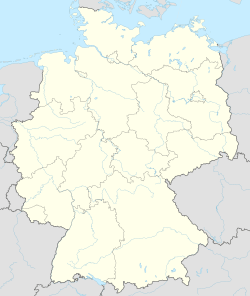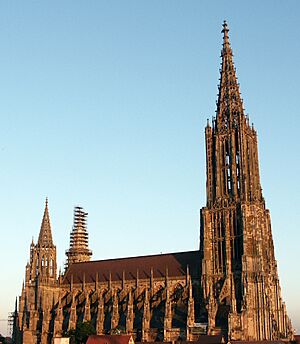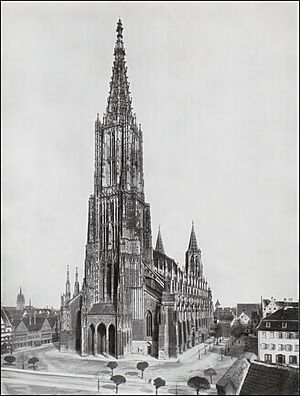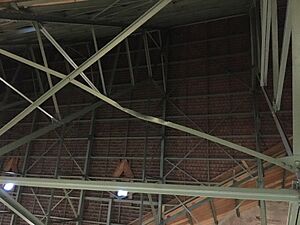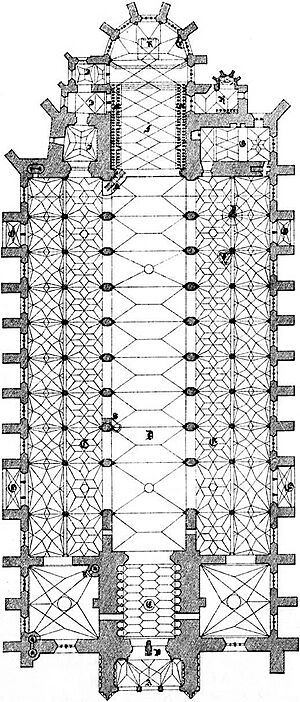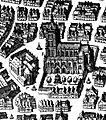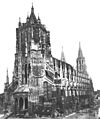Ulm Minster facts for kids
Quick facts for kids Ulm Minster |
|
|---|---|
|
Ulmer Münster (German)
|
|
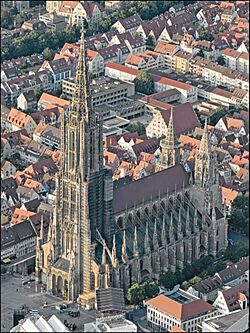
Ulm Minster, aerial view (2014)
|
|
| 48°23′55″N 9°59′33″E / 48.39861°N 9.99250°E | |
| Location | Ulm |
| Country | Germany |
| Denomination | Lutheran |
| Previous denomination | Catholic |
| History | |
| Status | Minster Parish church |
| Architecture | |
| Functional status | Active |
| Architect(s) | Heinrich Parler |
| Architectural type | Minster |
| Style | Gothic |
| Groundbreaking | 1377 |
| Specifications | |
| Capacity | 2,000 |
| Number of spires | 3 |
| Bells | 13 |
| Administration | |
| Division | Evangelical-Lutheran Church in Württemberg |
Ulm Minster (known in German as Ulmer Münster) is a magnificent Gothic church located in Ulm, a city in the German state of Baden-Württemberg. It was first built as a Catholic church but became a Lutheran church in the 16th century during a time of big religious changes.
This impressive church was the tallest church in the world with its towering steeple reaching 161.53 meters. It held this record until October 30, 2025, when the Sagrada Família in Barcelona surpassed it. When its main towers were finished in 1890, Ulm Minster was also the fifth-tallest structure in the entire world.
Even though it is huge, Ulm Minster is not a cathedral. A cathedral is the main church where a bishop has their official seat. Ulm Minster has never been home to a bishop. While its beautiful towers and decorations are made of stone, many of its walls are actually built from visible brick. This is why it is sometimes called a "brick church." It is one of the largest brick churches, similar in size to San Petronio Basilica in Bologna and Frauenkirche in Munich.
Construction of Ulm Minster began in the Late Middle Ages with the Gothic style. However, it took many centuries to complete, finally finishing in the late 19th century. When work paused in the 16th century, most of the church was already built, except for the very top parts of the towers and some outer decorations.
Visitors can climb 768 steps to reach the top of the minster's spire. From 143 meters up, you get an amazing view of Ulm and the nearby city of Neu-Ulm. On a clear day, you can even see the Alps mountains in the distance! The very last part of the climb is a narrow, spiraling staircase, just wide enough for one person.
Contents
The Long History of Ulm Minster
Building Begins: 1377-1543
The people of Ulm wanted a new church inside their city walls. Their old church was outside the city, which caused problems during conflicts. So, in 1377, the citizens decided to pay for a new church themselves. Mayor Ludwig Krafft laid the first stone on June 30, 1377.
The first architect, Heinrich Parler, planned a "hall church." This meant the side areas (aisles) would be almost as tall as the central part (nave). Many different master builders worked on the church over the years. Ulrich Ensingen became the master builder in 1392. He planned the incredibly tall 150-meter spire. To make the church look balanced with such a tall spire, the central nave was made much higher than first planned. The church was officially opened in 1405.
Later, in 1477, Matthäus Böblinger made some changes to the plans. These changes caused a big problem: the heavy roof structures (vaults) pushed too hard on the columns, threatening the church's stability. A new builder, Burkhart Engelberg, fixed this by strengthening the tower's base. He also replaced the heavy aisle vaults with lighter, narrower ones, adding more columns. This saved the church from collapsing.
In 1530 and 1531, the people of Ulm voted to become Protestant during the Reformation. Ulm Minster then became a Lutheran church. Even though it is very large, it is not a cathedral because the main bishop for this church lives in Stuttgart.
Construction stopped in 1543 when the steeple was about 100 meters tall. Work paused for many reasons. These included changes in religion and politics, as well as economic problems. New trade routes were discovered, which led to less money coming into Ulm. This meant there was no longer enough money for such a huge building project.
Construction Resumes and Completes: 1844-1890
In 1817, the colorful paintings inside the church were covered with grey paint. Then, in 1844, construction work started again. After some repairs, the central part of the church (nave) was made stronger with new supports called flying buttresses. Smaller steeples were built next to the choir, even though there were no old plans for them.
Finally, the main steeple was completed. Its design was changed slightly to make it about ten meters taller than originally planned. On May 31, 1890, the entire building was finished after centuries of work.
Ulm Minster During World War II
Ulm suffered heavy bombing on December 17, 1944. Much of the town was destroyed, especially west and north of the church. However, Ulm Minster itself was only slightly damaged. Most other buildings around the town square were badly hit, and about 80% of Ulm's old city center was ruined.
On March 1, 1945, a 500 kg bomb fell into the choir area of the minster but luckily did not explode.
Recent Updates and Renovations
The Minster Tower was closed for renovations after the first platform (70m) and parts of the nave were closed to visitors starting in March 2023. By August 2024, the tower reopened up to the second platform. Only the very top part remains closed for visitors.
The Bells of Ulm Minster
The tower holds 13 bells in total, but only 10 of them swing to ring. Six of these bells, including the largest one called Gloriosa (a bourdon), were made in 1956. Three other bells are used for the clock. The Leichenglocke chimes every quarter-hour, and then the second largest bell, Dominica, rings out the hours. A small bell called the Schlagglocke also chimes the hours just before Dominica.
Nine of the ten main bells ring using electronic controls. However, one special bell, the Schwörglocke, is only rung by hand on a day called Oath Monday. This Schwörglocke is also the oldest bell in the Minster. In Germany, bells are always numbered from largest to smallest, so Bell 1 is always the biggest.
| No. | Name (German) | Name (International) | Mass
(kg) |
|---|---|---|---|
| 1 | Gloriosa (Bourdon Bell) | 4,912 | |
| 2 | Dominica (2nd Bourdon Bell) | 4,301 | |
| 3 | Große Betglocke | Large prayer bell | 3,800 |
| 4 | Leichenglocke | Funeral bell | 1,750 |
| 5 | Kleine Betglocke | Small prayer bell | 1,766 |
| 6 | Kreuzglocke | Cross bell | 1,248 |
| 7 | Landfeuerglocke | Country fire bell | 900 |
| 8 | Taufglocke | Baptismal bell | 506 |
| 9 | Schiedglocke | Arbitration bell | 345 |
Architecture and Art Inside
Building Materials and Design
The walls of the choir, the side aisles, and the tower were built using brick. However, the upper parts of the central nave are made from sandstone blocks, which came from a place called Isny im Allgäu. A small amount of limestone from the nearby Swabian Jura hills was also used.
Amazing Works of Art
- Sculptures: Look for medieval sculptures above the main Western entrance. The tympanum (the decorated space above the doorway) shows scenes from the Book of Genesis. On the central column, you will see a sculpture called the Man of Sorrows, created by a local artist named Hans Multscher.
- Choir Stalls: The church has famous 15th-century choir stalls made by Jörg Syrlin the Elder. These wooden seats are carved from oak and feature hundreds of detailed busts (sculptures of heads and shoulders).
- Pulpit Canopy: The beautiful canopy above the pulpit was made by Jörg Syrlin the Younger.
- Main Altar: The original main altar was destroyed during the Reformation. The current altarpiece, from the early 16th century, is a triptych (a three-part artwork). It shows figures of the Holy Family and the Last Supper at its base (predella).
- Stained Glass Windows: The five colorful stained glass windows in the apse (the rounded end of the church) show stories from the Bible. They were made in the 14th and 15th centuries.
- The Organ: The church's main organ was also destroyed during the Reformation and replaced in the late 16th century. The famous composer Wolfgang Amadeus Mozart played this organ in 1763. For a while, it was the largest organ in the world! It was rebuilt in the 1960s to improve its sound.
- Jeremiah Statue: In 1877, the Jewish community of Ulm, including Hermann Einstein (the father of Albert Einstein), donated money for a statue of the Biblical prophet Jeremiah. This statue is placed below the main organ.
- Modern Art: Later renovations added interesting gargoyles and a sculpture called The Beggar, created by the artist Ernst Barlach.
Church Layout and Size
Here is a simple plan of Ulm Minster:
- A. Entrance hall.
- B. Main porch.
- C. Tower hall.
- D. Nave (the central part of the church).
- E. Aisles (the side parts of the church).
- F. Choir (where the choir sings).
- G. Sacristy (a room for clergy and church items).
- H. Besserer Chapel.
- J. Reithart Chapel.
- K. High altar.
- L. Old tabernacle.
- M. Choir stalls (seats for the choir).
- N. Tabernacle.
- O. Baptismal font.
- P. Holy-water font.
- Q. Side porches.
- R. Organ entrance.
- S. Pulpit (where sermons are given).
Key Measurements
- The steeple is an amazing 161.53 meters tall.
- The church is 123.56 meters long and 48.8 meters wide.
- The total area of the building is about 8,260 square meters.
- The central nave is 41.6 meters high, and the side naves are 20.55 meters high.
- The entire building has a volume of about 190,000 cubic meters.
- The main steeple alone weighs an estimated 51,500 tons.
- Today, the church can seat a congregation of 2,000 people.
- In the Middle Ages, before pews (fixed seats) were common, it could hold up to 20,000 people!
Images for kids
-
Virgil by Jörg Syrlin t.E., possibly a self-portrait
See also
 In Spanish: Iglesia mayor de Ulm para niños
In Spanish: Iglesia mayor de Ulm para niños
- Gothic cathedrals and churches
- Strasbourg Cathedral
- Cologne Cathedral
- Gothic architecture
- Protestant Reformation
- List of tallest structures built before the 20th century


